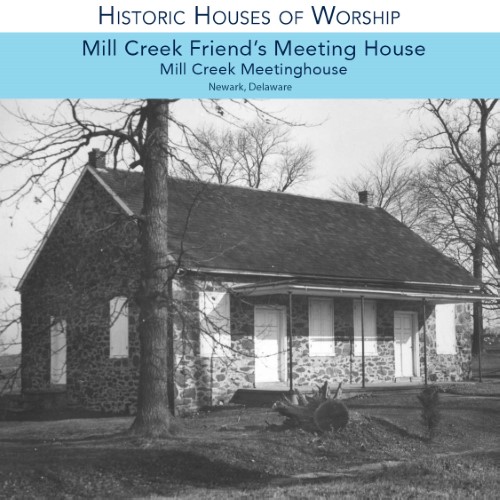


“Mill Creek Friend’s Meeting-House is located one mile north of Corner | Ketch. In 1838, James Thompson and thirty-two Friends requested New Gar-den Meeting for the indulgence of a Meeting in Mill Cree Hundred. At a meeting held at his home on Oct. 16, 1838, the request was granted. Mr. Thompson’s home is still standing and is located adjoining the meeting-house property on the north. The privilege of building a meetinghouse was also granted. The present stone meeting-house was then built.
It was completed and had been in use by Feb. 19, 1841. On that date, James Thompson, for a consideration of $1.00 deeded the meeting-house site, consisting of one and one-half acres of land, to David Eastburn, John Thompson, Jr., Thomas Mitchel, Samuel Loyd, Lewis Fell and Marshall Yeatman, members of the Mill Creek Meeting who acted as trustees. In the deed Mr. Thompson reserved the timber which he could cut at his convenience. The meeting-house faces south as is customary with Friend’s Meeting-Houses and there is a date-stone in the western gable but it is undated. There is the usual “horse block” known also as an “upping block” and an “up and on block.”
In 1901, the mid-week Meetings, with the exception of the Preparative Meetings, were discontinued. The time of holding the Preparative Meetings In 1915, all Meetings were discontinued except on the first first-day of each month. In 1925, the Preparative Meetings were discontinued. Since 1930, only occasional Meetings are held. An annual Meeting is held on the first-day be-fore Labor Day.
In common with most Friend’s Meetings, there is a fund for maintenance of the property, provided chiefly by bequests from members. The meeting-house and burial-ground are kept in immaculate condition. The old horse-sheds were removed in 1937. The oldest tombstone is that of an infant, George F. Tyson, who died on July 24, 1844. Several fighting Quakers are buried here and their graves are decorated with the insignia of the Grand Army of the Republic.
A plot in the burial-ground is set aside for the burial of indigent persons who are not Friends. At midnight on each Feb. 28, the neighbors claim they hear a shotgun discharged near stranger’s row. William Lozone, Dutch Billy, was a hard-working man-of-all-work in that section, especially noted for his ability as a butcher. He lived alone, with his hunting dogs, in a small shack in the woods on the Lamborn farm. He was famous as a hunter and could be heard at all hours of the night firing his shotgun. In 1921, Dutch Billy, be-coming despondent, gradually gave away his dogs and on the night of Feb. 28, set fire to his shack, went deep into the woods and with his shotgun com-mitted suicide. He would have been buried in Potter’s Field except for the fact that the good neighbors of that section, led by J. Leslie Eastburn, took up a “camptown.” This was sufficient to give him a good burial in the stranger’s row in the meeting-house burial-ground and to place a stone marker over his grave. The question arose as to the disposal of his gun, his only earthly pos-session, and it was decided to bury it with him. This was done with the gun resting in his arms. It is this gun that the neighbors believe they hear fired at _ midnight each year on the anniversary of his death.” (1)